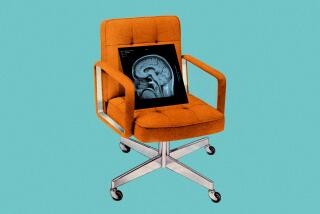Head Cases
- Share via
Good people can have a bad day. And when those people are pilots or railroad engineers, a bad day can spread to hundreds of others.
For years, scientists have wondered whether it would be possible to develop a simple, unobtrusive “bad-day” test for workers in critical industries. It would have to be fast and reliable, and it would have to detect a potential for impaired performance that might result from various factors, such as alcohol and drug use, fatigue, illness and extreme stress.
It is possible now to measure for alcohol or drugs, but the tests hardly qualify as “simple” or “unobtrusive.” Besides, many accidents involve neither alcohol nor drugs.
Will there be a simple method to determine in advance whether professionals are experiencing problems that could affect their work? And will there ever be a way to monitor them minute by minute to determine whether their performance is deteriorating during their duty periods?
Scientists are optimistic that such technology can be developed, but there is widespread disagreement about whether a number of devices now hitting the market can fill the bill.
This burgeoning branch of behavioral science is called “fitness for duty” or “readiness to perform” testing. Much of it is in the experimental stage, but several companies are marketing devices. They generally break down into two groups:
* Computer-based skill tests that measure simple motor skills, reaction time, memory, spatial perception or problem solving.
* Eye-reaction tests that measure the rate of eye movement and the reaction of the pupil to light.
Devices that use either approach can keep a computerized record of each worker’s performance and compare each new test to an individual average. None of them can determine exactly what has caused an abnormal or substandard result.
“I think all of these are interesting approaches,” says Mark Rosekind, head of the fatigue countermeasures program at NASA’s Ames Research Center. “The problem is, there’s no data to say one of these is better than the other.”
Other scientists disagree. Martin Moore-Ede, of Circadian Technologies Inc. in Cambridge, Mass., a prominent researcher in the field of biological clocks, has adopted the eye-reaction approach, using PMI Inc.’s 30-second eye test, which measures involuntary eye reactions to light plus the eye’s saccadic velocity--the speed with which it follows a moving target.
“We’ve taken a look at many of them,” Moore-Ede says. “This was the one that struck me as superior in a number of ways.”
He says the eye functions measured by the device are affected by numerous physiological and psychological factors and can’t be consciously controlled by the person being tested. In contrast, he says, skill-based programs can be fooled, an assertion disputed by their manufacturers.
PMI, of Rockville, Md., is one of several companies marketing a commercial version of such eye tests. Its product has undergone extensive validation studies, including research at an Alcoa Aluminum plant in Texas, a Federal Railroad Administration fatigue study and a fatigue study of soldiers in combat conducted at Walter Reed Army Medical Center.
Other companies have focused on skill testing, such as Performance Factors Inc. of Alameda, Calif., which markets Factor 1000, an eye-hand coordination test that can operate on any IBM-compatible computer. Using a control panel with a knob, a subject attempts to hold steady a pointer on the screen that appears to move randomly.
Eventually, the movement of the pointer exceeds the subject’s ability to control it. Once each worker establishes an individual base line over several days, the test can detect when psychomotor performance capabilities are impaired.
Civil liberties groups support fitness-for-duty tests because they do not involve invasion of individual privacy. The American Civil Liberties Union says those tests get to the heart of the issue: whether a person can safely perform a task, not whether the individual has violated a law.
Some scientists say more work needs to be done before the testing devices come into widespread use.
Kirby Gilliland and Robert E. Schlegel, of the University of Oklahoma, in a 1993 report for the Federal Aviation Administration, said “numerous issues” need to be addressed, including more research to determine what factors best predict readiness to perform, as well as the possible hidden costs of such testing.
But the key problem with fitness-for-duty tests is that, so far, they only measure a worker’s condition at the beginning of a shift. There is no technology to continuously rate a person’s fitness during work periods.
“The technology, as far as it goes, appears to be valid,” says William Keppen, a vice president with the Brotherhood of Locomotive Engineers who has spent more than a decade working on fatigue issues. “But the concern is, it really only measures an individual’s state when he comes to work.”
Preliminary data from an engineer fatigue study, sponsored by the BLE and the Federal Railroad Administration, indicate that current schemes to keep engineers alert don’t always work. Engineers put through a week of “severe” work schedules at the Illinois Institute of Technology’s locomotive simulator in Chicago were often able to reset the locomotive “alerter” even when they were asleep.
But Keppen says the ongoing simulator tests have produced an unexpected bonus. Researchers have been able to determine that engineers’ alertness was beginning to flag long before they experienced sleep or “near-sleep events.” This offers hope, he says, that systems could be developed to monitor an engineer for dangerously low levels of alertness, perhaps signaling a dispatcher or stopping the train.





